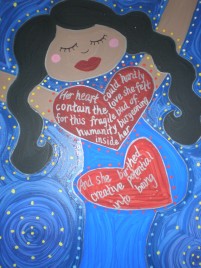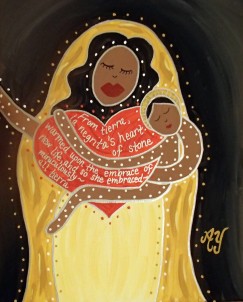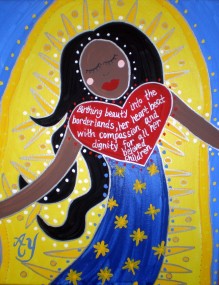
It’s no secret that the holidays are often a difficult time for queer people. Disproportionately estranged from family, we often must create our own family. While these chosen families can be tremendously life-giving, it’s tough not to long for our families of origin during Christmas time. Many still in relationship with family are forced to retreat to the closet for fear of safety or exclusion this season.
Queer folk who have affirming families of origin still experience the twang of heteronormativity in holiday commercials, family events, and church services throughout December. There’s a reason why many refer to it as “Blue Christmas,” because, well, the holidays can leave us feeling pretty blue when our identities are invalidated, excluded, questioned, or marginalized.
In every nativity scene, we see images of a so-called “holy family” that likely doesn’t look very much like the family’s most queer folk create: a straight, cisgender couple, and a baby. This family is lauded by the Church as the quintessential iteration of what family should look like. When our families don’t look anything like this, it’s easy to see how celebrating the birth of Jesus is fraught with emotional and spiritual hardship.

There is good news, though. We can subvert this narrative of traditional family by queering the story. So, I’d like to talk a bit about the revolutionary power of queering Mary. Abolitionist and Women’s Rights Activist, Sojourner Truth, said it best at the 1851 Ohio Women’s Convention. Once a slave, Truth questioned the whitewashing done to women of color by white women working only for white women’s right to vote by asking the famed question, “Ain’t I a woman?” In that same speech, she notes that male clergy claim that women “can’t have as much rights as men ‘cause Christ was a man.”
This adage is familiar, not only to women, but also to LGBTQs who have been told that our iterations of family aren’t real or true or right because they don’t reflect the so-called holy family of Joseph, Mary, and Jesus. In an act of theological brilliance and subversion, Sojourner Truth poses this question to the male clergy gathered at the convention: “Where did your Christ come from? Where did your Christ come from? From God and a woman. Man had nothing to do with him!”

I’d contend that Truth’s words queered traditional understandings of Mary. She was responsible for birthing Jesus, for ushering Emanuel into the world. Man had nothing to do with it. If we take this a step further, borrowing from feminist theology and boldly claiming that God is a She, then we queer the Christmas narrative even further. Mary and She Who Is (God) brought Jesus into the world. Jesus had two moms!

As I paint myriad cultural iterations of Mary, I think of Truth’s subversive proclamation. I think of the difficulty of this season. I think of the powerful potential of a Queer Mary that emboldens, empowers, and enlivens the queer community to be proud of who we are, to honor and celebrate the beauty of the families we create amidst outside threat. Mary knew a little something about the difficulty of creating a family amidst outside threat, didn’t she? She wasn’t married to Joseph, which was tremendously scandalous during her time. Scripture tells us she was a virgin, so that makes her pregnancy pretty complicated. She had to travel far while pregnant with Jesus. She gave birth in a manger because no one would welcome her family. And then the king wanted her child dead.
For those of us who have created queer families by bringing children into the world, we can relate to the hardship of Mary’s pregnancy. It was three years before I had legal rights connecting me to my child because the government didn’t dub my relationship with my wife legal; I was merely a legal stranger in our home. There are countless families who would never welcome us into their homes because they view our queer family as wrong, sinful, an abomination. Want to know about tough pregnancies? Ask a few queer families about the measures they had to take to bring a child into the world. And, yes, throughout the world there are “kings” (political leaders) who would rather have us dead than alive; their legislation reflects this.
So, I’d contend that Mary’s very being, her family, and the entirety of Christmas is actually quite queer. As I collaborate with Trans Latinx Constructive Philosophical Theo-Ethicist and Scholar-Activist, Dr. Robyn Henderson-Espinoza, on a project to Queer Mary, we marinate on the myriad beautiful and subversive ways in which different manifestations of Mary queer the traditional Christmas story in art and theology.

I think of the borderlands where Our Lady of Guadalupe dwells in Mexico, embodying difference and diversity in one inspiring being. I think of La Negrita and how she chose to appear to least among us in Costa Rica. I think of the Virgin de la Caridad and her close association with Yoruban Oshun, saving all from watery chaos in Cuba, or the Virgin de la Regla’s association with Yoruban Yemanya and her fierce love of all her children, including you and me. I think of Oya and her connection with Our Lady of Candelaria creating destruction in order to bring about winds of change and new life on the Canary Islands. I think of Mary—porous enough to cross and transgress and subvert and embrace all borders—birthing new life with She Who Is and ushering light into the world.
It’s not that we must queer Mary’s story or being. We simply must look close enough, peel back the layers of history, peak into the forgotten crevices of the canon, and trust our queer vision, for what we see is nothing less than a queer saint with a belly full of divinity embracing us in all our beautiful diversity. So, when you find yourself dwelling in the Christmas blues, remember that Mary’s color in iconography is blue. Cling to her queer spirit and hold your head high, for divinity dwells within you, as well.
Rev. Dr. Angela Yarber has a PhD in Art and Religion from the Graduate Theological Union at UC Berkeley and is author of Embodying the Feminine in the Dances of the World’s Religions, The Gendered Pulpit: Sex, Body, and Desire in Preaching and Worship, Dance in Scripture: How Biblical Dancers can Revolutionize Worship Today, Holy Women Icons, Tearing Open the Heavens: Selected Sermons from Year B,Microaggressions in Ministry: Confronting the Violence of Everyday Church, and Holy Women Icons Contemplative Coloring Book. She has been a clergywoman and professional dancer and artist since 1999. For more on her research, ministry, dance, or to purchase one of her icons, visit: www.angelayarber.com



Thank you for this beautiful edgy view of Mary. I’ve long loved her appearance at Tepeyac outside of Mexico City for all the layers of meaning that story brings (and sadly are still ignored by so many in the patriarchal church). Your paintings bring me such a smile.
LikeLike
Thanks so much!
LikeLike
This Advent I have been thinking a lot of God as Mother and now I have a sound bite: “Jesus had two moms!” Yes!
LikeLiked by 1 person
For sure! Spread the good news of Jesus’ two moms far and wide!
LikeLike
Thanks Angela. I always enjoy your art that illustrates your heart and spirit. I think you summed it all up in your last sentence: “divinity dwells within you”. and within all of creation. That’s what Christmas means for me.
LikeLiked by 1 person
Thanks and agreed. If only everyone treated everyone as though divinity dwells within…We’d have a much kinder world.
LikeLike
What an inspiring essay. And Like you at this time of year Mary/Goddess is much on my mind. My particular favorite goddess is Guadalupe -as you say -” embodying difference and diversity.” This year I am spending the season in New Mexico in a small northern mountain town and am dismayed by the “whitened” versions of Guadalupe that seem to abound in pueblo country. Even here in Indian country we cannot allow Guadalupe to be who she is…
LikeLiked by 1 person
Very true. The church and society has a way of whitewashing most saints. White supremacy at its worst.
LikeLiked by 1 person
Thank you so much for this beautiful post. Like many others, I go through these weeks in December feeling as if everyone else is celebrating something I do not really, as a woman who envisions Divinity as a She, relate to. Now, during the next two weeks, I can think of this post, and celebrate, too!
This has just reminded me of many years ago when I was setting up our creche scene for my family and decided to combine the figures from two or three inherited creche sets we had to make a creche scene with two Marys and no Joseph… only my feminist sister noticed! Hmmm… maybe time to do that again!
LikeLiked by 1 person
Yes, and besides the “two moms” if we see Jesus as Wisdom Incarnate (I mean, really, why else would God have come) then not only are we in the season but it becomes our story to tell!
LikeLike
I’d say it’s certainly time to do that again! Great idea.
LikeLike
Angela, I love your post! Like Carolyn, and probably many of us, I struggle with Christmas since I envision God as God/dess. Well, I also have other issues with Christmas, but your post is a huge help! :)
LikeLike
Very nice information mam. I liked it..
LikeLike